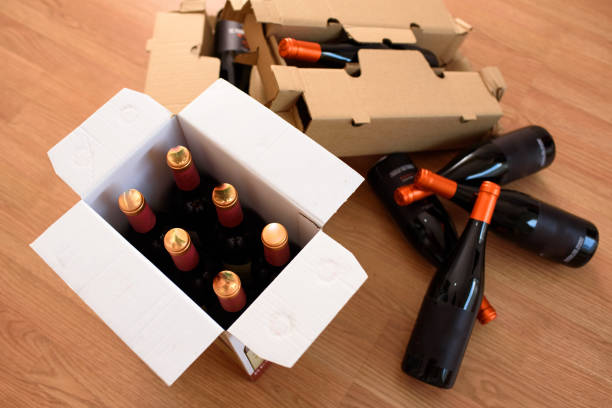
Top 5 Eco-Friendly Innovations in Wine Shipping Boxes
Traditional wine packaging often contributes to pollution, excessive carbon emissions, and a concerning volume of landfill waste, which can be incredibly harmful to the earth. However, the tide is turning, with more consumers seeking eco-friendly alternatives. This shift prompts companies like Wine Shipping Boxes to explore sustainable wine storage and distribution options.
In this article, we will be discussing friendly innovations utilized by wine shipping boxes.
Challenges with Traditional Wine Packaging
Firstly, let's review a few challenges with traditional wine shipping.
Producing wine already poses environmental challenges, from pulp waste to agricultural emissions. However, the packaging used for transporting wine bottles compounds these issues. Materials like bubble wrap, polystyrene, and plastic foam contribute to excessive plastic use, resulting in harmful environmental consequences.
- Excessive use of plastic:
Wine packaging has always used materials such as packaging, polystyrene and foam plastic, which causes global warming. These materials are generally non-biodegradable and can persist in the environment for centuries. The widespread use of plastic in wine packaging has raised concerns about contamination and its impact on ecosystems, marine life and general environmental health.
- Carbon emissions from transportation:
Transporting bottled alcohol in conventional weight and volume containers results in higher gas and carbon emissions. Heavier packaging requires more fuel to be transported, increasing the wine industry's carbon footprint. This challenge highlights the environmental impact of traditional packaging methods and the need for more sustainable changes to reduce the industry's overall greenhouse gas emissions.
- Prohibited recycling:
Alcohol packaging products such as bubble wrap and plastic foam are now commonplace for recycling. Many of these materials cannot be easily recycled or accepted by manufacturers. Therefore, these materials are often thrown into landfills, resulting in non-biodegradable waste. This ban on recycling increases the environmental impact of traditional wine packaging and highlights the importance of exploring other environmentally friendly alternatives.
Top 5 Eco-Friendly Innovations in Wine Shipping Boxes
Embracing Compostable Materials
Compostable materials take center stage in the quest for sustainability. Wine Shipping Boxes is exploring packaging solutions that can naturally decompose in aerobic soil within weeks, creating nutrient-rich soil. This approach alleviates the planet's strain and provides an eco-friendly alternative to traditional packaging materials.
Recycling for a Second Life
Another avenue for sustainability is the use of recycled materials. Wine Shipping Boxes actively incorporates non-toxic recycled paper, cardboard, and recyclable plastic into its packaging solutions. This reduces carbon footprints and allows the packaging to have a second life.
Lightweight Designs for Greener Transport
The weight of packaging materials plays a significant role in sustainability. Lighter designs require less fuel for transportation, resulting in lower gas-related emissions. Wine Shipping Boxes is exploring lightweight distribution options that align with a commitment to environmentally conscious practices.
Catering to Consumer Preferences
Consumer preferences are evolving, with a growing majority influenced by sustainable packaging choices. Wine Shipping Boxes recognizes this shift and actively explores and implements packaging designs that align with consumer values.
Ensuring Quality and Safety in Sustainable Solutions
One common concern with sustainable alternatives is the perceived compromise in safety and durability. Wine Shipping Boxes addresses this concern by investing in sustainable packaging solutions that ensure structural integrity and durability without sacrificing product safety.
Tips for Seamless Transition to Sustainable Packaging
Reducing carbon emissions
An important step in the transition to sustainable packaging is the importance of reducing carbon emissions. Businesses can analyze their current carbon footprint, identify areas for improvement, and implement strategies to reduce emissions. This will include improving transport efficiency, using environmentally friendly packaging and investing in energy savings in production.
Simplifying logistics for sustainability
Optimizing logistics is important to reduce the environmental impact of packaging. By improving production and distribution, companies can reduce the overall carbon footprint of their products. This may include identifying effective products, using products in real-time, and investigating alternative shipping methods, such as environmentally friendly shipping options.
Educate customers about safety
Customer awareness plays a vital role in the success of sustainable packaging changes. Businesses must communicate effectively with their target audiences about the transition to an environmental culture, highlighting environmental benefits and encouraging smart choices. Educating consumers about the importance of sustainable packaging can increase awareness of environmental responsibility and support for environmentally friendly brands.
Lightweight design
Reducing the weight of packaging will help reduce carbon emissions during transportation. Heavy-duty design requires less fuel for transportation, providing a safer, more secure environment. Businesses can explore new materials that are lightweight yet sustainable while meeting environmental and operational goals.
Collaborate with value-added suppliers
Working with suppliers who share a commitment to environmental practices ensures a seamless transition to sustainable packaging. Businesses should look for suppliers that provide materials with good environmental properties, such as recyclable or biodegradable materials. Collaborating with security-focused vendors ensures the reliability of the data packaging environment and supports the broader goal of reducing impact across equipment.
Final Thoughts
Wine Shipping Boxes is moving towards a more sustainable approach to wine packaging. The shift towards eco-friendly materials aligns with evolving consumer preferences and positions the company as a leader in environmentally conscious practices. Here's to a future where each bottle of wine brings joy to the consumer and contributes to a greener world. Cheers to sustainable sips!
